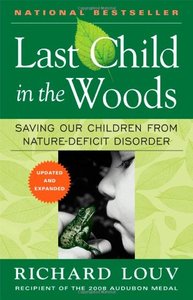Last Child in the WoodsSaving Our Children From Nature-Deficit Disorder
|

|
 Diese Seite wurde seit 3 Jahren inhaltlich nicht mehr aktualisiert.
Unter Umständen ist sie nicht mehr aktuell.
Diese Seite wurde seit 3 Jahren inhaltlich nicht mehr aktualisiert.
Unter Umständen ist sie nicht mehr aktuell.
 Zusammenfassungen
Zusammenfassungen

In this influential work about the staggering divide between children and the outdoors, child advocacy expert Richard Louv directly links the lack of nature in the lives of today's wired generation—he calls it nature-deficit—to some of the most disturbing childhood trends, such as the rises in obesity, attention disorders, and depression.
Last Child in the Woods is the first book to bring together a new and growing body of research indicating that direct exposure to nature is essential for healthy childhood development and for the physical and emotional health of children and adults. More than just raising an alarm, Louv offers practical solutions and simple ways to heal the broken bond—and many are right in our own backyard.
This new edition reflects the enormous changes that have taken place since the book was originally published. It includes:
- 100 actions you can take to create change in your community, school, and family.
- 35 discussion points to inspire people of all ages to talk about the importance of nature in their lives.
- A new progress report by the author about the growing Leave No Child Inside movement.
- New and updated research confirming that direct exposure to nature is essential for the physical and emotional health of children and adults.
Last Child in the Woods: Saving our Children from Nature Deficit Disorder has spurred a national dialogue among educators, health professionals, parents, developers and conservationists. This is a book that will change the way you think about your future and the future of your children.
 Dieses Buch erwähnt ...
Dieses Buch erwähnt ...
 Dieses Buch erwähnt vermutlich nicht ...
Dieses Buch erwähnt vermutlich nicht ... 
 Tagcloud
Tagcloud
 Erwähnungen auf anderen Websites im Umfeld von Beat Döbeli Honegger
Erwähnungen auf anderen Websites im Umfeld von Beat Döbeli Honegger
| Website | Webseite | Datum |
|---|---|---|
| Argumente gegen das Digitale in der Schule | Wald-Argument | 20.09.2011 |
 Zitationsgraph
Zitationsgraph
 Zitationsgraph (Beta-Test mit vis.js)
Zitationsgraph (Beta-Test mit vis.js)
 8 Erwähnungen
8 Erwähnungen 
- Education for Tomorrow - A Biocentric, Student-Focused Model for Reconstructing Education (Michael Risku, Letitia Harding) (2013)

- The Nature of Technology - Implications for Learning and Teaching (Michael P. Clough, Joanne K. Olson, Dale S. Niederhauser) (2013)

- 5. Computer Savvy but Technologically Illiterate - Rethinking Technology Literacy (Teresa J. Shume)
- it's complicated - the social lives of networked teens (danah boyd) (2014)


- Allein im Wald - das war einmal (Ev Manz) (2014)


- Digitale Hysterie - Warum Computer unsere Kinder weder dumm noch krank machen (Georg Milzner) (2016)

- 3. Wie gefährlich sind Computerspiele?
- Glow Kids - How Screen Addiction Is Hijacking Our Kids-and How to Break the Trance (Nicholas Kardaras) (2016)

- Die Smartphone-Epidemie - Gefahren für Gesundheit, Bildung und Gesellschaft (Manfred Spitzer) (2019)

- Science and Drama - Contemporary and Creative Approaches to Teaching and Learning (Peta J White, Jo Raphael, Kitty van Cuylenburg) (2021)


- New Eden - Mediating Pre-service Teachers’ Conceptions of Education for Sustainable Development (Debbie Myers)


- New Eden - Mediating Pre-service Teachers’ Conceptions of Education for Sustainable Development (Debbie Myers)
 Co-zitierte Bücher
Co-zitierte Bücher

Media in the Lives of 8- to 18-Year-Olds
(Victoria J. Rideout, Ulla G. Foehr, Donald F. Roberts) (2010)

 Volltext dieses Dokuments
Volltext dieses Dokuments
 Standorte
Standorte 
 Bibliographisches
Bibliographisches 
 Beat und dieses Buch
Beat und dieses Buch
Beat hat dieses Buch während seiner Zeit am Institut für Medien und Schule (IMS) ins Biblionetz aufgenommen. Beat besitzt kein physisches, aber ein digitales Exemplar. (das er aber aus Urheberrechtsgründen nicht einfach weitergeben darf). Es gibt bisher nur wenige Objekte im Biblionetz, die dieses Werk zitieren.









 Angst
Angst Familie
Familie Fernsehen
Fernsehen Freizeit
Freizeit Gesundheit
Gesundheit Internet
Internet Kinder
Kinder Leben
Leben Wahrnehmung
Wahrnehmung





 Biblionetz-History
Biblionetz-History